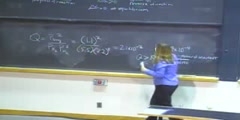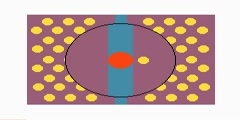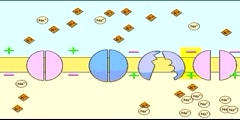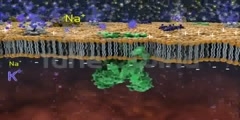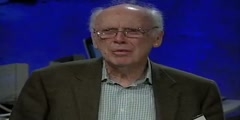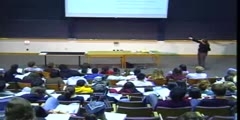Lec 3 - Double Minima, Earnshaw's Theorem and Plum-Puddings
"Lec 3 - Double Minima, Earnshaw's Theorem and Plum-Puddings" Freshman Organic Chemistry (CHEM 125) Continuing the discussion of Lewis structures and chemical forces from the previous lecture, Professor McBride introduces the double-well potential of the ozone molecule and its structural equilibrium. The inability for inverse-square force laws to account for stable arrangements of charged particles is prescribed by Earnshaw's Theorem, which may be visualized by means of lines of force. J.J. Thomson circumvented Earnshaw's prohibition on structure by postulating a "plum-pudding" atom. When Rutherford showed that the nucleus was a point, Thomson had to conclude that Coulomb's law was invalid at small distances. 00:00 - Chapter 1. Distinguishing Equilibrium and Resonance 06:37 - Chapter 2. The Structure and Surface Potential of Ozone 20:57 - Chapter 3. Visualizing Electrostatic Force: Earnshaw's Theorem 35:07 - Chapter 4. J. J. Thomson's Plum Pudding Model Complete course materials are available at the Open Yale Courses website: http://open.yale.edu/courses This course was recorded in Fall 2008.
Video is embedded from external source so embedding is not available.
Video is embedded from external source so download is not available.
Channels: Chemistry (General)
Tags: Equilibrium Earnshaw's Theorm Inverse-sqare force Well potential
Uploaded by: yalefreshorganic ( Send Message ) on 05-09-2012.
Duration: 45m 3s
Here is the next lecture for this course
Lec 2 - Force Laws, Lewis Structures and ...
50:13 | 2667 viewsLec 5 - Work-Energy Theorem and Law of Co ...
01:10:16 | 4523 viewsChemical Science - Chemical Equilibrium - ...
42:55 | 22236 viewsChemical Science - Chemical Equilibrium ( ...
44:32 | 16084 viewsLec 22 - Risk Aversion and the Capital As ...
01:16:07 | 2539 viewsLec 11 - Orbital Correction and Plum-Pudd ...
49:27 | 2713 viewsChemical Science - Wavelike Properties of ...
46:09 | 14156 viewsLec 15 - Backward induction: chess, strat ...
01:12:39 | 3491 viewsHow chemical equilibrium is achieved in cells
01:28 | 17508 viewsUnderstanding Action Potential and Nerve ...
02:45 | 89025 viewsAction Potential & Epilepsy
08:11 | 52933 viewsTalks James Watson: The double helix and ...
20:11 | 11601 viewsA proof for pythagorean theorem
00:32 | 5161 viewsGarfield's proof for pythagorean theorem
01:33 | 5440 viewsChemical Science - Acid-Base Equilibrium: ...
49:24 | 7531 viewsNo content is added to this lecture.
This video is a part of a lecture series from of Yale
Lecture list for this course
Lec 2 - Force Laws, Lewis Structures and Resonance
Lec 4 - Coping with Smallness and Scanning Probe Microscopy
Lec 6 - Seeing Bonds by Electron Difference Density
Lec 7 - Quantum Mechanical Kinetic Energy
Lec 8 - One-Dimensional Wave Functions
Lec 9 - Chladni Figures and One-Electron Atoms
Lec 10 - Reality and the Orbital Approximation
Lec 11 - Orbital Correction and Plum-Pudding Molecules
Lec 12 - Overlap and Atom-Pair Bonds
Lec 13 - Overlap and Energy-Match
Lec 14 - Checking Hybridization Theory with XH_3
Lec 15 - Chemical Reactivity: SOMO, HOMO, and LUMO
Lec 16 - Recognizing Functional Groups
Lec 17 - Reaction Analogies and Carbonyl Reactivity
Lec 18 - Amide, Carboxylic Acid and Alkyl Lithium
Lec 19 - Oxygen and the Chemical Revolution (Beginning to 1789)
Lec 20 - Rise of the Atomic Theory (1790-1805)
Lec 21 - Berzelius to Liebig and Wöhler (1805-1832)
Lec 22 - Radical and Type Theories (1832-1850)
Lec 23 - Valence Theory and Constitutional Structure (1858)
Lec 24 - Determining Chemical Structure by Isomer Counting (1869)
Lec 25 - Models in 3D Space (1869-1877); Optical Isomers
Lec 26 - Van't Hoff's Tetrahedral Carbon and Chirality
Lec 27 - Communicating Molecular Structure in Diagrams and Words
Lec 28 - Stereochemical Nomenclature; Racemization and Resolution
Lec 29 - Preparing Single Enantiomers and the Mechanism of Optical Rotation
Lec 30 - Esomeprazole as an Example of Drug Testing and Usage
Lec 31 - Preparing Single Enantiomers and Conformational Energy
Lec 32 - Stereotopicity and Baeyer Strain Theory
Lec 33 - Conformational Energy and Molecular Mechanics
Lec 34 - Sharpless Oxidation Catalysts and the Conformation of Cycloalkanes
Lec 35 - Understanding Molecular Structure and Energy through Standard Bonds
Lec 36 - Bond Energies, the Boltzmann Factor and Entropy
Lec Last - Potential Energy Surfaces, Transition State Theory and Reaction Mechanism



